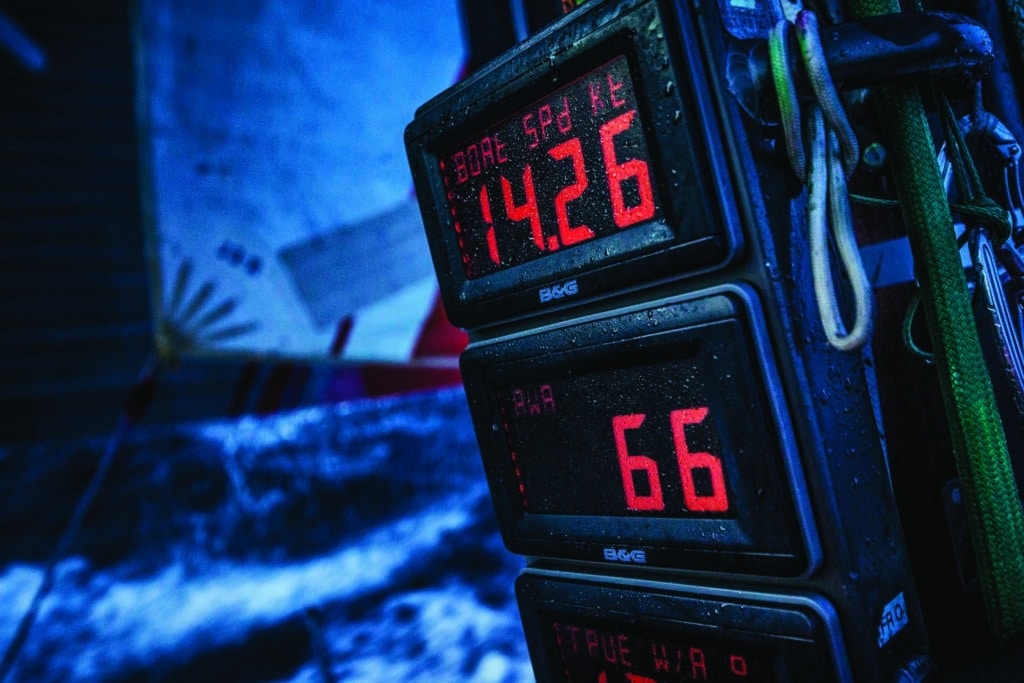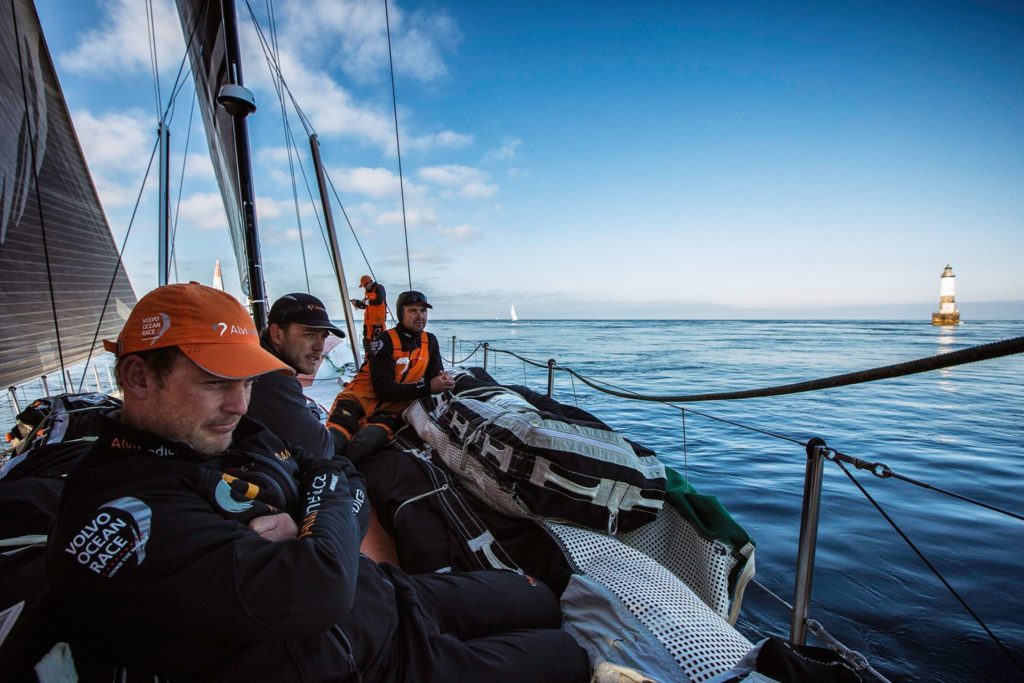
Volvo Ocean Race 2014-15 – Leg 7 to Lisbon
The more I sail, the more I realize that, like most everything, the best approach is a balanced one. Having said that, I think that you can ditch your instruments more often than you think — use what you know — and then use your instruments to validate your seat-of-the-pants feel and as a communication tool.
Most of us carry only one or two instruments aboard our boats — usually a compass and, if you consider a masthead fly a type of instrument, one of those as well. As you move up the technology ladder and the boats get bigger or more complex, you add a speedo and then perhaps some electronic masthead instruments. Of course, there are many more rungs on the technology ladder — the sky’s the limit — but for our purposes, we’ll stick to these basic levels.
Garbage In, Garbage Out
Blinking red lights don’t suddenly appear next to our instruments when they aren’t perfectly calibrated, and if they’re not reading correctly, we can go blindly along, following the numbers right into the back of the pack. This even occurs on some of the most sophisticated boats. I remember sailing TP52s in Spain, and being on the final approach to the weather mark. We were lifted, but once we passed the offset mark and turned down, our true wind direction told us we were headed. This happened at every windward mark for a few days, so I asked the navigator to help me figure out what was going on. We looked at our tracks overlapped on the chart, and it confirmed my feeling that something funny was happening with the instruments.
Our navigator dug deeper and discovered that our compass had a sector that was affected by something in the boat. As a result, it was inputting a heading that was 5 degrees off and changing the true wind direction solution. Luckily, because we were in a sea-breeze venue, our heading was nearly the same out of most windward marks, and we figured it out. With that said, we still missed a few opportunities for an early jibe while we were scratching our heads looking at the instruments, thinking we had missed something in all the action of the spinnaker set.
So how do you know whether your readings are accurate? At the end of the day, the most reliable guide is your heading relative to the boats around you, and how it changes as you go through lifts and headers. If the instruments say you’re getting lifted, but the boat next to you, to leeward and forward, is gaining, you might have an instrument problem. Or, conversely, if you’re the windward boat and your instruments show a big header, yet you start gaining, look to the instruments. Trust what you’re seeing with the other boats and you’ll seldom go wrong.
By knowing your tacking and jibing angles, you can also compare heading, windspeed and wind-direction numbers from tack to tack or jibe to jibe. Are you getting numbers that are consistent with what you saw on the other tack or jibe? If not, you might have a calibration issue.
When to Ignore the Compass
The compass is the most reliable tool you have. For me, it’s the go-to instrument. I never completely ditch the information it’s providing, just override it or let it take a back seat. I might do this when there are some serious geographical considerations. For instance, say I know I must get to the shoreline — perhaps there’s a big header there, or maybe more velocity. As I sail toward the shore, the compass will say we are headed, but it will pay to continue on. A similar situation occurs when one side of the course is favored because of current. It doesn’t make any difference what the compass says; I’ve got to find a way to get over there. Finally, I’ll override the compass when, just after rounding a leeward mark, I have to get to a side to avoid another fleet that’s coming down. If I followed the compass, I’d tack and end up right in the disturbed wind and waves from those boats. I take a piece of sticky-back and write down my heading and the true wind direction on both tacks and both jibes, and post this in the cockpit. For each tack and jibe, I write down my numbers for max lifted, max headed and average. This log starts in the pre-race tune-up, and I update it after any race. I’ll fill in missing numbers by using jibing or tacking angles. By having the numbers posted, you can see anomalies in your computed true wind direction. That’s my backup.

The Knotmeter Is Not God
Many people rely too heavily on the absolute boatspeed number. Most boats read differently on one tack than another because the paddle wheel is off centerline or angled slightly. As you heel, water accelerates differently around the hull. The boat may be going exactly the same speed on both tacks, but because the wheel is deeper on one side than the other, water moves more quickly past the wheel on one tack than another, and you get a higher reading on that tack. If you’re not aware of that tendency, you can spend a lot of time on the so-called “slower tack,” trying to find out what’s wrong with the rig and sails when in fact everything is set up identically, or else reaching around trying to go the same speed on both tacks.
Another common mistake is to compare boatspeed numbers to your target speed or competitors’ numbers without taking both with a grain of salt. I was sailing with a guy who was good friends with a competing skipper, and when they compared notes about upwind speed in certain conditions, my skipper discovered his numbers were a couple of tenths lower than his competition. So he started pressing the boat, always sailing a bit lower for more speed. I remember that the mainsheet trimmer and I spent an entire frustrating event trying to get him to come up. Whenever he did head up, the speed dropped a couple of tenths and our performance improved. He kept saying: “This guy said he was going 8.3. We’re only going 8.1.”
We had tuned with his friend’s boat on many occasions, and I knew this was simply a boatspeed calibration issue. I wholeheartedly believed our numbers, but our performance was suffering, and the helmsman would not listen. Finally, I had to change the boatspeed calibration so we would actually sail upwind and not reach around. The helmsman was simply focusing too much on our competitor’s numbers and not paying attention to how the boat felt. As it turned out, this was all due to a different calibration number for the speedo.
When Average Is Not Average
Imagine you’re sailing upwind, and your instruments say that 8 knots is your target speed. When you tack, the helmsman and sail trimmers will typically work to get the speed back to 8 knots on the new tack as quickly as possible. You have the bow down and the sails eased, pressing the boat to get up to 8 knots.
Once the boat reaches 8 knots, you trim on the sails and head up. But you won’t stay at 8 knots. Instead, you’ll see 8.1, 8.2 or even 8.3. The reason for this is that, usually, there’s a five- to seven-second averaging on the boatspeed. That prevents the number from jumping all over the place, which is good. But the downside is that if you actually wait until you hit that number, you’ll be too late. You tack, go down to 6 knots, and then start leaning on it to accelerate. So you could already be at 8 knots, but because the boatspeed is averaging over the past five to seven seconds, including the current value, it might read only 7.8. To avoid that problem, come up before it gets to the target number. You might need to ignore the target speed for the moment and start coming up at 7.5 or 7.6. If you don’t, you’ll end up pressing too long, and then, as you come up, the number might say 8.4. Then you’ll sail high, trying to get back to the target speed, and the up-down cycle will continue until the instruments slowly get to the right number. And that’s simply because you’re not taking into consideration that the speed is averaging when you’re looking at it. When you’re at the final angle and your sails are fully trimmed, you want to be at your target speed. If it doesn’t jump over, you’ve done it correctly.
Forget the Fly
There are certain conditions in which I typically put the least weight on masthead instruments — even masthead flies, such as a Windex — because the wind at the top of the mast is affected greatly by the sails and how they are trimmed. Sometimes these instruments just aren’t accurate, such as in a light, building sea breeze, especially when the sea breeze is slightly different from the direction of the gradient. The wind is filling in at different layers, and the instruments are not good at detecting that. It’s always worse in light air. The problem is that the instruments are just reading off the top of the rig, so you’re sailing along and look at the water and see less wind, but you look at your instruments and nothing has changed. Any time the wind weight — meaning how well it mixes from the top of the rig to the bottom — is different, it’s an issue. If you were to go up 100 feet, it might be blowing 20 knots, but that would change as you went down, depending on factors such as air temperature, water temperature and topography. It can be 20 knots up high, but it just doesn’t mix well down low. Wind sheer can also produce misleading instrument readings, particularly in light air.
We’ve all sailed downwind in light air, with a symmetric spinnaker, and discovered we couldn’t trim the pole so it was perpendicular to the Windex. That’s wind sheer: The wind is coming from a different direction at the top of the mast than it is down low. When that happens, forget the Windex and focus on correct sail trim.









